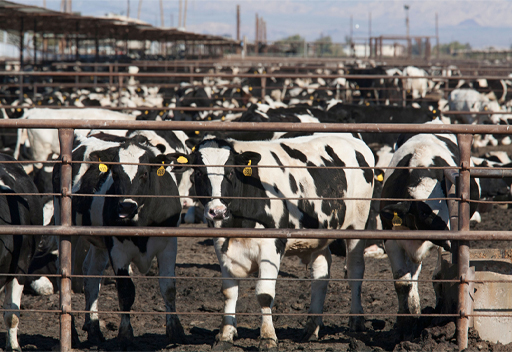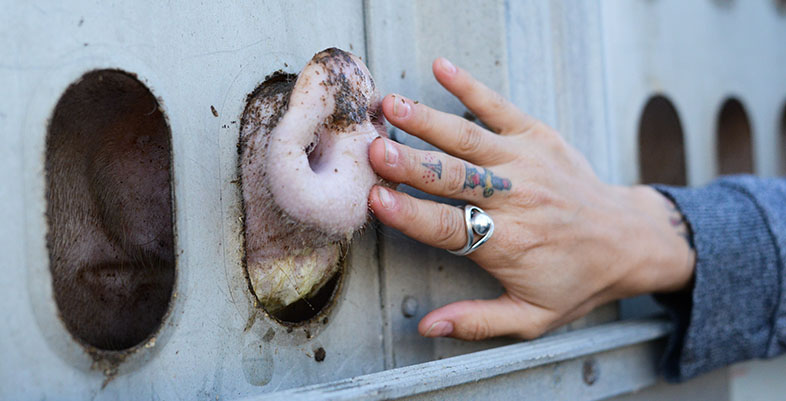2.3 ‘Livestock’ farming and environmental harm
All farming requires the use of resources, but ‘livestock’ farming tends to be more resource-intensive than alternatives. Two key farming resources are land and water. In terms of land, ‘livestock’ farming accounts for 70 per cent of all agricultural land worldwide. It also uses a third of all arable land, to provide crops to feed ‘livestock’. Providing this land exacerbates deforestation (Kemmerer, 2015), in turn eroding planetary capacity to absorb carbon dioxide (CO2). CO2 is a key greenhouse gas (GHG) responsible for anthropogenic climate change (that is, caused by human activity) (Garnett, 2013). By contrast, a recent research review concluded that plant-based diets could sustain the global human population from half the agricultural land currently in use (Chai et al., 2019). In terms of water, ‘livestock’ farming often depends on irrigation using finite fresh water supplies. Animal-protein production has been calculated to use more than four times as much water as the most intensively-irrigated plant-based protein production (Reynolds et al., 2014). Globally, ‘livestock’ farming is responsible for 29 per cent of agricultural fresh water use (Chai et al., 2019).

Pollution is also a consequence of ‘livestock’ farming, particularly the intensive production methods which confine large numbers of nonhuman animals in a small space. For instance, concentrated animal feeding operations (CAFOs), enclose many thousands of animals in one facility, producing vast quantities of waste (manure and urine). Food campaigner Chris Hunt (2015) calculates that a 15,000-cow CAFO generates waste equivalent to a city of 315,000 humans. CAFO waste is discharged into the environment legally, for instance as fertiliser, or illegally as spills from artificial lagoons built to contain it, which can amount to millions of gallons. Spills may be intentional or accidental, for instance caused by storms, but regardless of cause, they directly kill fishes and other aquatic animals. They also cause eutrophication, a process by which the excess nutrients in CAFO waste stimulate the growth of algae on the surface of water. This blocks sunlight, which kills underwater plants eaten by aquatic animals (Hunt, 2015). Intensive ‘livestock’ farming also pollutes the air with hydrogen sulphide and ammonia (toxic to humans and other animals). You will note, these are all also examples of collateral harm.
As you read above in relation to deforestation and CO2, ‘livestock’ farming is one of the major anthropogenic sources of GHGs. The production of methane and nitrous oxide is also a major contributory factor. ‘Meat and dairy production processes account for 80% of all GHGEs [greenhouse gas emissions] from the food sector and 24% of total GHGEs’ (Chai et al., 2019).
One consequence of humanocentrism, is the tendency to consider humans as being apart from nature, which is treated as an inexhaustible resource for human use. This is especially evident in commercial fishing, where the indiscriminate killing of uncounted numbers of aquatic animals is accepted as routine. However, as the criminologist Gary Potter argues, ‘[f]rom a social science perspective, it becomes clear that the social world cannot be understood in separation from the natural world’ (2016, p. 7). Potter’s argument addresses one of the challenges of exploring environmental harms, which is that from a humanocentric perspective, they can seem rather abstract and remote from the suffering of specific individuals. This means that the exploration of environmental harms is an urgent task for criminology and particularly the emerging sub-discipline of green criminology (Spapens et al., 2016).
Moreover, the scale of the social and environmental harms attendant to ‘livestock’ farming has increased as human consumption of ‘animal products’ has accelerated in recent decades. Globally, the number of other animals slaughtered for human food more than quadrupled in the 40 years between 1974 and 2014 (Ritchie and Roser, 2017), a period in which the human population did not quite double (The World Bank, 2019). This acceleration might be interpreted as an expression of a natural demand for ‘animal products’, but to do so would be to overlook the social processes that not only construct demand, but also make it appear to be ‘natural’, and therefore inevitable, rather than contingent.
So to conclude Section 2:
- Large numbers of nonhuman animals are harmed as a result of the routine operation of many social structures. These can therefore be conceptualised as ‘social harms’.
- ‘Livestock’ farming and fishing harm more nonhuman animals than any other human activity, resulting in hundreds of billions of deaths every year, as well as non-lethal harms that have physical, mental and emotional dimensions.
- ‘Livestock’ farming and fishing generate environmental harms which include depletion of land and water resources; water and air pollution, including GHGEs; and collateral harms such as ‘bycatch’.
